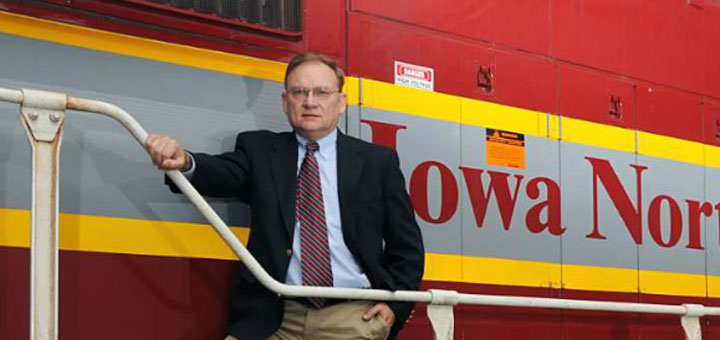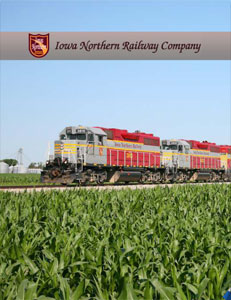Business View Magazine profiles The Iowa and Northern Railway Company, a short line railroad located in Cedar Rapids, Iowa.
The old rock island line gets back on track
“The Rock Island Line is a mighty good road,
The Rock Island Line is the road to ride.
If you want to ride, you gotta ride it like you find it,
Get your ticket at the station for the Rock Island Line.”
The above lyrics are from “Rock Island Line,” an American blues/folk song, first recorded by John Lomax in 1934, and later popularized by Lead Belly (Huddie William Ledbetter), the Louisiana-born, Afro-American singer and musician. Many versions have been recorded by other artists, most significantly, the worldwide, hit version in the mid-1950s, by Lonnie Donegan.
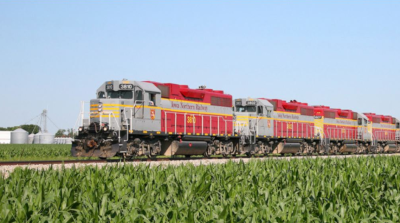 The real Rock Island Line was actually incorporated in Illinois back in 1847 as the Rock Island and La Salle Railroad Company. Over the next hundred years, the ever expanding rail network carried an untold number of goods and passengers across the American Midwest – Arkansas, Colorado, Illinois, Kansas, Missouri, Nebraska, New Mexico, Oklahoma, South Dakota, and Texas. The easternmost reach of the system was Chicago; it also reached southeast to Memphis, Tennessee. To the west, the Rock Island reached Denver, Colorado, and Santa Rosa, New Mexico. Southernmost tracks led to Galveston, Texas, and Eunice, Louisiana, while in a northerly direction, the Rock Island got as far as Minneapolis, Minnesota. The first train to operate in the state of Iowa steamed from Davenport to Muscatine in 1855.
The real Rock Island Line was actually incorporated in Illinois back in 1847 as the Rock Island and La Salle Railroad Company. Over the next hundred years, the ever expanding rail network carried an untold number of goods and passengers across the American Midwest – Arkansas, Colorado, Illinois, Kansas, Missouri, Nebraska, New Mexico, Oklahoma, South Dakota, and Texas. The easternmost reach of the system was Chicago; it also reached southeast to Memphis, Tennessee. To the west, the Rock Island reached Denver, Colorado, and Santa Rosa, New Mexico. Southernmost tracks led to Galveston, Texas, and Eunice, Louisiana, while in a northerly direction, the Rock Island got as far as Minneapolis, Minnesota. The first train to operate in the state of Iowa steamed from Davenport to Muscatine in 1855.
But by the mid-twentieth century, parts of the original Rock Island Line were anything but “the road to ride.” In addition to growing competition from the trucking industry, onerous regulations made it “impossible to be profitable” in the railroad sector, according to Daniel R. Sabin, Owner and President of the Iowa Northern Railway Company (IANR), the corporate inheritor of what was once part of the Rock Island Railroad’s mainline from Minneapolis to Chicago. “Under the regulated climate, we couldn’t even reduce our rates,” he explains. “We had to go to the Interstate Commerce Commission and get permission to make any changes. And it did not allow the railroads to go out and be aggressive in capturing more truck business.”
Sabin has been a railroad man his whole adult life. He grew up in Manly, Iowa, a town at the northern end of the line that runs diagonally through the northeast quadrant of the state, northwest to southeast, from Manly to Cedar Rapids. He started his career as a student telegrapher on the Rock Island in 1968 and was the youngest train dispatcher in the United States at age 18. In addition to his stint with the Rock Island Line, Sabin also ran the Iron Road Railways, based in Alexandria, Virginia, which owned and operated various short line operations, including the former Bangor and Aroostook System. He has also worked at CSX Transportation and the Canadian Pacific Railway. Prior to the purchase of the Iowa Northern, Sabin presided over his own transportation consulting firm.
He tells the story of the last days of the Rock Island Line’s “mighty good road”: “It was in a period before deregulation and all of the railroads were really struggling,” he begins. “The Rock Island and the Milwaukee both went into bankruptcy in the Midwest about the same time the Penn Central situation was going on out east. If they could have lived until deregulation, they probably would still be there, today. But, at that time they just ran out of cash. The tracks had deteriorated considerably. The line was in extremely bad shape from a track standpoint and an equipment standpoint. There was very little traffic left on the line; there were trees growing between the rails; farmers had put barbed wire fence across the track and turned it into pasture land. In the early 1980s, the Rock Island went through bankruptcy and the liquidation process. So the grain elevators along the line, along with a few investors, bought the railroad from the trustee in 1984.”
Sabin says that the new owners were committed to getting the railroad back on its feet, but “they didn’t have any experience in the railroad industry. It took them a couple of years to even get the line passable through the whole route from Manley to Cedar Rapids.” Then, a friend of his became President of the new line while Sabin was doing consulting work in Michigan. “He asked me to help him do a lot of contractual things and work on a marketing plan. He subsequently became disabled with a heart attack and so, in ’93, the owners of the line asked me if I would help them find a buyer. I told them I would as long as I could be considered as a potential candidate. And so, they agreed to that. There were a number of offers made for the company, but, fortunately, we had a relationship that was pretty strong, and a lot of trust, so they allowed me and a group of investors to buy the line from them. We closed in November, 1994, and set out to turn the company around.”
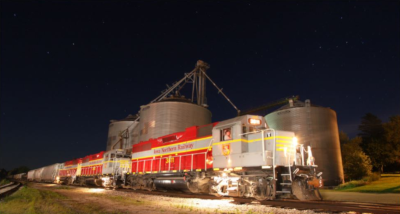 Sabin continues: “At that time, there were only 325 loads per month generated on the line – a little bit of overload traffic from the Chicago/Northwestern. The rates were higher than the truck rates; the service was very bad. They only had 63 hopper cars and they had five locomotives, but only one was generally running on any given day. So, I convinced my brother, Mark, who was, at the time, Director of Commuter Operations for the Chicago/Northwestern in Chicago, to come out and join me, along with my partner, Pete Collins, as we set out on a turnaround process and started growing the business.
Sabin continues: “At that time, there were only 325 loads per month generated on the line – a little bit of overload traffic from the Chicago/Northwestern. The rates were higher than the truck rates; the service was very bad. They only had 63 hopper cars and they had five locomotives, but only one was generally running on any given day. So, I convinced my brother, Mark, who was, at the time, Director of Commuter Operations for the Chicago/Northwestern in Chicago, to come out and join me, along with my partner, Pete Collins, as we set out on a turnaround process and started growing the business.
“There was roughly a four million dollar mortgage owed to the state of Iowa’s Railway Authority, and we found that we had to generate some cash to start rebuilding the railroad. But there was just no credit available. So our attorney, Scott Bannister, came up with a very creative plan to sell the rail of the Iowa Northern under a lease arrangement. We generated around eight million in cash by selling it and then taking it back on a ten-year lease. That gave us the money to pay off the existing mortgage to the state and generate some cash to start rebuilding the track. So, we pumped every penny we could find into ties, and road bed, and maintenance; we went out and leased some more locomotives and some more covered hoppers. It took us quite a while, but we did get the company turned around, and coming into 2000, we were able to qualify for some low-interest loans and some grant money – particularly through the state of Iowa – and we got the thing pretty well straightened around.”
Unfortunately, the better times for the Iowa Northern came to an abrupt end in 2008. “The first thing that hit us was the flood in June,” he says. “We lost two major bridges; neither one of them we owned, but we operated over them – a UP (Union Pacific) bridge at Waterloo and a CRANDIC (Cedar Rapids and Iowa City Railway) bridge at Cedar Rapids. Both of those were taken out by the floods, so we had to operate on a bifurcated line for 18 months, until the bridges could be restored. It was pretty ugly. After the floods, we had major droughts and then some wet planting seasons. We went about five years without our basic corn volumes – it was just about 30-40 percent of normal. But we had diversified with ethanol, chemicals, and a lot of other new industries along our line, so despite the fact that we lost our base business for that long, we were actually profitable through that period.”
That diversification has been a key element of the IANR’s resurgence. In 2010, 73 percent of its revenue was from corn and soybeans; now those commodities represent about 20 percent. Today, the railroad hauls such varied freight as machinery, chemicals, ethanol and ethanol-related products, distiller grains, caustic soda, hydrochloric acid, powdered and bentonite clay, tomato paste, lube oil, propane, potash, tractors, and meat. The IANR wind component distribution center at Manly is the largest in North America and a new steel distribution center will open in the summer of 2016.
“The third-party investment along our track hit $500 million last year from companies that want to locate on the Iowa Northern,” Sabin states. “We’re also very aggressive in establishing industrial parks under our own direction. And that has been very positive in getting companies that hear about us. Or they see a success story that we’ve done with our terminal operations and then they join us. So we’ve got a chemical/ethanol transfer terminal at Manly, called Manly Terminal, and we’re part owners with a trucking company. And it’s going very, very well. We’re doing quite well in acquiring and attracting new industries into that site.”
Sabin admits that being a local owner/operator gives his company a significant, home field advantage. “We’re very local,” he admits. “We’re part of every community and county and we know these folks, quite well. Amy (Amy Homan, the Director of Carload Marketing) spends a lot of time with the managers of the grain operators, the communities, and the mayors. We have a name and a face instead of just being a railroad flying through town. That makes a huge difference in getting that next industry onto the railroad.
“The other thing that’s real critical is, as a short line, we’re very unique because we connect with four other railroads,” Sabin adds. “A lot of short lines may have only one or two connections to the outside world; we’ve got options for our customers that allow them to leverage the routes, and the rates, and the service that they get from the larger Class 1 railroads.” The IANR’s own 26 locomotives, and another four that it leases, connect with virtually every rail system in the nation. There are direct connections to the Union Pacific, the Canadian National, the Cedar Rapids & Iowa City, and the Canadian Pacific. These connections make it possible to reach the Burlington Northern Santa Fe, the Kansas City Southern, CSXT, the Norfolk Southern, and the Iowa Interstate.
Investing in the railroad’s infrastructure is an ongoing process that has also contributed to the line’s success. In the past ten years, the IANR has spent more per mile in capital improvements than most of the country’s Class 1 carriers. “We’ve got a fairly substantial amount of money put into the track,” says Sabin. In fact, by the end of 2015, the company had spent over $100 million along the line in increased yard and side track capacity, 100,000 main line wood ties, 65,000 steel ties and 42.6 miles of new CWR (Continuous Welded Rail). Welded rail is normally laid in quarter mile sections, eliminating joints in the rail; it dramatically reduces the risk of derailments and maintenance costs.
And Sabin says that even more money will be spent over the next several years. “We’re focusing our attention on spending more money on infrastructure and more capacity,” he says. “Also, there are a number of low-density lines nearby that are owned by Class 1 carriers. We hope that we can work with them to expand our network and provide a lower cost operation to some of those lines, and grow the business like we have the Iowa Northern, and to share in that new prosperity with the owners.”
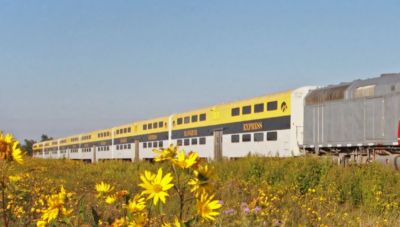 In the end, Sabin believes that the IANR’s true success has come from treating its customers as business partners. “In many cases, in the railroad industry, the larger companies tend to impose their levels of service rates on the customer and we try to design our company to be an extension of that customer’s own operation or logistics,” he explains. “When we took over the line, we cut the rates 20 percent on the first day, just to give our customers breathing space so that they could focus their attention on expansion of their loading facilities, their storage, and their infrastructure that allows them to grow. As long as we were treating them well, we could grow our business. So we went from somewhere around 1,200 cars of grain a year to about 16,000 in a period of 15 years. We’re a railroad that doesn’t act like a railroad. And that’s a very big deal. It certainly attracts and retains companies to our line that probably wouldn’t have ever gone on a railroad.”
In the end, Sabin believes that the IANR’s true success has come from treating its customers as business partners. “In many cases, in the railroad industry, the larger companies tend to impose their levels of service rates on the customer and we try to design our company to be an extension of that customer’s own operation or logistics,” he explains. “When we took over the line, we cut the rates 20 percent on the first day, just to give our customers breathing space so that they could focus their attention on expansion of their loading facilities, their storage, and their infrastructure that allows them to grow. As long as we were treating them well, we could grow our business. So we went from somewhere around 1,200 cars of grain a year to about 16,000 in a period of 15 years. We’re a railroad that doesn’t act like a railroad. And that’s a very big deal. It certainly attracts and retains companies to our line that probably wouldn’t have ever gone on a railroad.”
Today, because of the leadership of Dan Sabin and the 106 employees of the Iowa Northern Railway, at least one part of the old Rock Island Line is, once again, “a mighty good road to ride.” So, as the old song suggests, if you are looking to locate your business in the northeastern part of Iowa – anywhere from Manly to Cedar Rapids – and you need efficient rail transportation and high levels of service, you should surely “get your ticket at the station for the Rock Island Line.” All aboard!
AT A GLANCE
WHO: The Iowa and Northern Railway Company
WHAT: A short line railroad in eastern Iowa
WHERE: : Cedar Rapids, Iowa
WEBSITE: www.iowanorthern.com
PREFERRED VENDORS

Mid-America Car Inc – Mid America Car, Inc. (MAC) of Greater Kansas City has over 35 years’ experience in the locomotive and freight car inspection, repair, and modification industry. It was founded in 1978 by Curtis and Janice Blanc as an on-site unit coal-train maintenance contractor for Kansas City Power and Light. It began with one pickup truck and four employees. Today MAC has over 60 highly-skilled professionals with years of experience in the locomotive and freight car service industry. – www.midamericacarinc.com
DIG DIGITAL?
